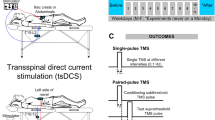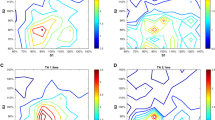Abstract
Transcranial direct current stimulation (tDCS) of the human motor cortex at an intensity of 1 mA has been shown to be efficacious in increasing (via anodal tDCS) or decreasing (via cathodal tDCS) the excitability of corticospinal projections to muscles of the hand. In this study, we examined whether tDCS at currents of 2 mA could effect similar changes in the excitability of deeper cortical structures that innervate muscles of the lower leg. Similar to the hand area, 10 min of stimulation with the anode over the leg area of the motor cortex increased the excitability of corticospinal tract projections to the tibialis anterior (TA) muscle, as reflected by an increase in the amplitude of the motor evoked potentials (MEPs) evoked by transcranial magnetic stimulation. MEP amplitudes recorded at rest and during a background contraction were increased following anodal tDCS and remained elevated at 60 min compared to baseline values by 59 and 35%, respectively. However, in contrast to the hand, hyperpolarizing cathodal stimulation at equivalent currents had minimal effect on the amplitude of the MEPs recorded at rest or during background contraction of the TA muscle. These results suggest that it is more difficult to suppress the excitability of the leg motor cortex with cathodal tDCS than the hand area of the motor cortex.


Similar content being viewed by others
References
Agnew WF, McCreery DB (1987) Considerations for safety in the use of extracranial stimulation for motor evoked potentials. Neurosurgery 20:143–147
Devanne H, Lavoie BA, Capaday C (1997) Input–output properties and gain changes in the human corticospinal pathway. Exp Brain Res 114:329–338
Fraser C, Power M, Hamdy S, Rothwell J, Hobday D, Hollander I, Tyrell P, Hobson A, Williams S, Thompson D (2002) Driving plasticity in human adult motor cortex is associated with improved motor function after brain injury. Neuron 34:831–840
Fregni F, Boggio PS, Lima MC, Ferreira, Wagner T, Rigonatti SP, Castro AW, Souza DR, Riberto M, Freedman SD, Nitsche MA, Pascual-Leone A (2006) A sham-controlled, phase II trial of transcranial direct current stimulation for the treatment of central pain in traumatic spinal cord injury. Pain 122:197–209
Hallett M (2003) Surround inhibition. Suppl Clin Neurophysiol 56:153–159
Hummel F, Celnik PA, Giraux P, Floel A, Wu WH, Gerloff C, Cohen LG (2005) Effects of non-invasive cortical stimulation on skilled motor function in chronic stroke. Brain 128:490–499
Hummel F, Cohen LG (2006) Non-invasive brain stimulation: a new strategy to improve neurorehabilitation after stroke? Lancet Neurol 5:708–712
Iyer MB, Mattu U, Grafman J, Lomarev M, Sato S, Wassermann EM (2005) Safety and cognitive effect of frontal DC brain polarization in healthy individuals. Neurology 64:872–875
Liebetanz D, Nitsche MA, Tergau F, Paulus W (2002) Pharmacological approach to the mechanisms of transcranial DC-stimulation-induced after-effects of human motor cortex excitability. Brain 125:2238–2247
Matsumura M, Sawaguchi T, Oishi T, Ueki K, Kubota K (1991) Behavioral deficits induced by local injection of bicuculline and muscimol into the primate motor and premotor cortex. J Neurophysiol 65:1542–1553
McCreery DB, Agnew WF, Yuen TGH, Bullara L (1990) Charge density and charge per phase as cofactors in neural injury induced by electrical stimulation. IEEE Trans Biomed Eng 37:996–1001
Miranda PC, Lomarev M, Hallet M (2006) Modeling the current distribution during transcranial direct current stimulation. Clin Neurophysiol 117:1623–1629
Nitsche MA, Paulus W (2000) Excitability changes induced in the human motor cortex by weak transcranial direct current stimulation. J Physiol (Lond) 527:633–639
Nitsche MA, Paulus W (2001) Sustained excitability elevations induced by transcranial DC motor cortex stimulation in humans. Neurology 57:1899–1901
Nitsche MA, Liebetanz D, Lang N, Antal A, Tergau F, Paulus W (2003a) Safety criteria for transcranial direct current stimulation (tDCS) in humans. Clin Neurophysiol 114:2220–2222
Nitsche MA, Schauenburg A, Lang N, Liebetanz D, Exner C, Paulus W, Tergau F (2003b) Facilitation of implicit motor learning by weak transcranial direct current stimulation of the primary motor cortex in the human. J Cogn Neurosci 15:619–626
Nitsche MA, Liebetanz D, Antal A, Lang N, Tergau F, Paulus W (2003c) Modulation of cortical excitability by weak direct current stimulation—technical, safety and functional aspects. Suppl Clin Neurophysiol 56:255–276
Nitsche MA, Nitsche MS, Klein CC, Tergau F, Rothwell JC, Paulus W (2003d) Level of action of cathodal DC polarization induced inhibition of the human motor cortex. Clin Neurophysiol 114:600–604
Nitsche MA, Seeber A, Frommann K, Klein CC, Rochford C, Nitsche MS, Fricke K, Liebetanz D, Lang N, Antal A, Paulus W, Tergau F (2005) Modulating parameters of excitability during and after transcranial direct current stimulation of the human motor cortex. J Physiol (Lond) 568:291–303
Nitsche MA, Niehaus L, Hoffmann K, Hengst S, Liebetanz D, Paulus W, Meyer BU (2004) MRI study of human brain exposed to weak direct current stimulation of the frontal cortex. Clin Neurophysiol 115:2419–2423
Nitsche MA, Doemkes S, Karakose T, Antal A, Liebetanz D, Lang N, Tergau F, Paulus W (2007) Shaping the effects of transcranial direct current stimulation of the human motor cortex. J Neurophysiol 97:3109–3117
Pascual Leone A, Valls-Solp J, Wassermann EM, Hallett M (1994) Responses to rapid-rate transcranial magnetic stimulation of the human motor cortex. Brain 117:847–858
Priori A (2003) Brain polarization in humans: a reappraisal of an old tool for prolonged non-invasive modulation of brain exciteability. Clin Neurophysiol 114:589–595
Stefan K, Kunesch E, Cohen LG, Benecke R, Classen J (2000) Induction of plasticity in the human motor cortex by paired associative stimulation. Brain 123:572–584
Talelli P, Rothwell J (2006) Does brain stimulation after stroke have a future? Curr Opin Neurol 19:543–550
Thomas SL, Gorassini MA (2005) Increases in corticospinal tract function by treadmill training after incomplete spinal cord injury. J Neurophysiol 94:2844–2855
Tokimura H, Di Lazzaro V, Tokimura Y, Oliviero A, Profice P, Insola A, Mazzone P, Tonali P, Rothwell JC (2000) Short-latency inhibition of human motor cortex by somatosensory input from the hand. J Physiol (Lond) 523:503–513
Yuen TGH, Agnew WF, Bullara LA, Jacques S, McCreery DB (1981) Histological evaluation of neural damage from electrical stimulation: considerations for the selection of parameters for clinical application. Neurosurgery 9:292–299
Acknowledgments
We wish to thank Dr K. Ming Chan for helpful discussions regarding tDCS, and the loan of his stimulator. Dr Kelvin Jones provided useful information concerning the current distribution within the cortex. DTJ was supported by a Natural Sciences and Engineering Research Council of Canada (NSERC) summer studentship and FDR was supported by an NSERC post-graduate scholarship. Additional funding was provided by the Canadian Institute of Health Research.
Author information
Authors and Affiliations
Corresponding author
Rights and permissions
About this article
Cite this article
Jeffery, D.T., Norton, J.A., Roy, F.D. et al. Effects of transcranial direct current stimulation on the excitability of the leg motor cortex. Exp Brain Res 182, 281–287 (2007). https://doi.org/10.1007/s00221-007-1093-y
Received:
Accepted:
Published:
Issue Date:
DOI: https://doi.org/10.1007/s00221-007-1093-y




